Shopping for Hunting Monoculars and Thermal Scopes?
You’ve come to the right place.
Thermal optics, including scopes, and thermal monoculars are great tools for hunting or shooting in low-light and poor-weather conditions.
Thermal monoculars, and scopes are not just useful for nighttime use, however. You can also use thermal optics during the day to spot animals through thick brush, low-light wooded areas, and dark environments such as a cave.
What's in This Guide?
In this buying guide, we review and compare the best thermal scopes, binoculars, and monoculars for hunting.
We chose to review all three types of thermal optics together to give you a flavor for when and where you might need each type.
If you prefer the hands-free convenience of NV goggles, then check our review of the best night vision goggles.
How Thermal Imaging Works
Thermal imaging, whether in a thermal scope or a thermal camera, works off the same scientific principles.
A special sensor collects infrared radiation from the target object. Infrared detectors create a temperature pattern of the object or environment, what's known as a thermogram.
The thermogram is then translated into an electric signal processed by a circuit board into a display.
You see on the screen or eyepiece are the different colors representing the intensity of infrared radiation collected from the environment.
Because an animal will be warmer than the environment, it'll easily stand out in the final image.
The 10 Best Monoculars and Scopes for Hunting
FLIR Scout TK
Best for up to 100 yards visibility
Thermal Sensor:
160 x 120
Detection range:
100 yards
Pulsar Axion Key XM30
Best for scouting and spotting
Thermal Sensor:
320 x 240
Detection range:
1,300 yards
FLIR Breach
Best for helmet mounting
Thermal Sensor:
320 x 256
Detection range:
225 yards
MARK 4 Spotting Scope
Best Spotting Scope
FLIR Scout TK Handheld Thermal Imaging
Most Compact
Thermal Sensor:
160 x 120
Detection range:
100 yards
ATN ThOR 4
Best rifle scope
Thermal Sensor:
384 x 288
Detection range:
1,000 yards
Pulsar Axion Thermal Monocular
Best Long-Range
Thermal Sensor:
320 x 240
Detection range:
1300 yards
ATN ThOR 4 640
Best thermal resolution
Thermal Sensor:
640 x 480
Detection range:
830 yards
FLIR Ocean Scout TK Monocular
Best budget
Thermal Sensor:
160 x 120
Detection range:
100 yards
ATN OTS-HD 384
Best for clear and sharp images
Thermal Sensor:
384 x 288
Detection range:
625 yards

For people who mostly do close-up hunting and need a quick spotting tool, the FLIR Scout TK is a great choice.
You can detect animals, including smaller ones like squirrels, from up to 100 yards out.
Its pocket-sized design and super light weight makes the Scout TK easy to carry around.
Pros
- Great for close to mid-range animal spotting.
- Compact and lightweight – easy portability.
- Multiple palette options.
- You can take photos and videos.
- Good price.
Cons
- Relatively low resolution.
- No magnification.
- Not ideal for observing moving animals because of the low refresh rate.
Our Review
The FLIR Scout TK thermal monocular is ideal for beginners or people looking for an affordable thermal scope for basic hunting and animal spotting.
The price is much lower than most thermal scopes (especially for a FLIR product), but you should understand what you are getting.
For one, you will only be able to detect warm objects up to 100 yards away. At this range, you can make out large animals easily. For smaller animals like birds or squirrels, you’ll need to be closer to tell which animal it is.
The resolution is also on the low side. The 160 x 120 sensor produces a good quality image, but only at close range. It’s one reason why the Scout TK’s detection range is limited to 100 yards. Beyond that, the image is too fuzzy.
What we love most about the Scout TK is its portability. It weighs 6 ounces and can fit in your pocket. The included lanyard makes it easy to carry it around safely when you are out in the woods.
You’ll also love the photo and video recording capability. You can cycle through multiple color palettes when taking photos or recording videos, too.
To transfer media to another device, the Scout TK comes with a USB cable that you’ll also use to charge the scope.
The Li-ion battery provides about 5 hours of continuous use.
Limitations
The FLIR Scout TK has limited imaging performance, which is expected for an entry-level thermal monocular.
The resolution, refresh rate, and detection range are all on the low end of modern day thermal imagers.
Because of the low resolution, the Scout TK lacks magnification, as zooming in would further distort image quality.
If you are looking for a high-resolution, high-magnification thermal monocular you can use for spotting distant animals, the Scout TK is def. not it.
Bottom Line
While it does have limitations, the FLIR Scout TK is a perfect tool for close to mid-range large animal spotting. Beginners will also love its low price and ease of use.
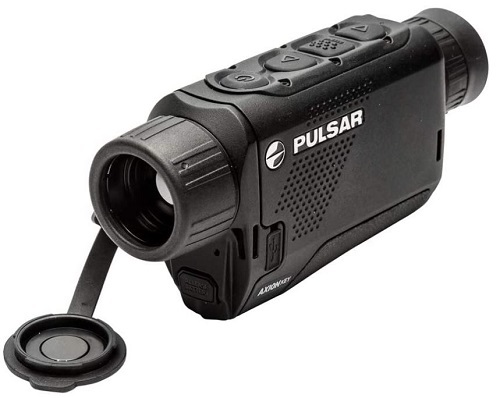
The Pulsar Axion Key XM30 is a major step up from the FLIR Scout TK in almost every aspect - especially in terms of resolution, magnification, and detection.
With a
useful detection range of up to 1,300 yards, the XM30 is an excellent long- and short-range spotter for large and small game.
Pros
- Long detection range.
- Waterproof (IPX7).
- Video and photo recording.
- Compact and lightweight.
- High magnification for long-range spotting.
- Supports live streaming.
Our Review
The FLIR Scout TK is fine short-range spotter but isn’t much help when trying to scout far away animals or small game.
The Pulsar Axion Key has a 13X greater effective range - up to 1,300 yards - so big game hunters and animal lovers will miss nothing with this unit.
The Axion Key has excellent optical & digital zoom, helping you observe animals from a safe distance. The optical/stepped zoom goes up to 2x, and starting at 4x the optics are supplemented by 4x digital zoom.
While zooming, you can engage the PiP or Picture in Picture mode. This lets you magnify your target in a small window at the top of the display while retaining a clear view of the environment.
The 320 x 240 sensor doesn’t have the highest resolution, but it’s plenty good enough for spotting. The only time you might find it limiting is when you zoom in too much. The image gets a bit fuzzy.
You can take photos and record videos using the Axion Key XM30 monocular, up to the internal memory limit of 16GB.
The XM30 monocular supports the Stream Vision app. Just connect the XM30 to your phone over WiFi to download the free Stream Vision app.
You can then use your smartphone as a remote viewfinder, a remote control, and a remote video/photo recorder. You can also Livestream your adventures via the app.
The 3200 mAh battery is good for up to 4 hours. Recharging requires a USB connection to a battery pack or 12V inverter.
The Axion Key XM30 is built to withstand rugged outdoor environments while being easy to carry around. It has a lightweight & tough aluminum body and is rated IPX7 (waterproof).
Limitations
The XM30 certainly has a better resolution & range than the Scout TK.
But the XM30 is still limited in terms of image quality. The 320 x 240 resolution proves inadequate when you zoom in too far. You’ll find it easier to get closer to your target rather than relying entirely on the zooming.
There’s also the issue of price. The XM30 is more than three times the price of the Scout TK. If you are looking for a budget thermal scope, this is not it.
Bottom Line
With improved optics, rugged and lightweight construction, and live streaming capability, the Axion Key XM30 is worth the higher price tag for hunters who want to see more than a hundred yards away.
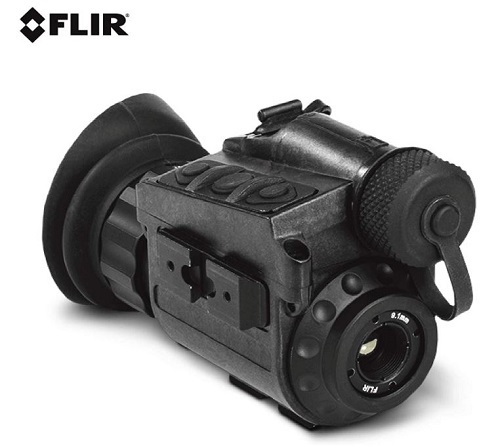
The FLIR Breach PTQ136 is designed primarily for law enforcement. But there’s no reason you cannot use it for hunting and animal spotting.
The integrated railing allows you to mount it on a helmet for hands-free spotting.
Pros
- Great for close to mid-range animal spotting.
- It can be mounted on a helmet.
- Digital zoom.
- A high refresh rate ensures smooth images when you are on the move.
- Good resolution.
Cons
- Pricey.
- Limited detection range.
Our Review
A helmet-mounted monocular is convenient when you need your hands free to hold a hunting rifle. It also provides better spotting when you or the animal is on the move.
FLIR Breach comes ready for helmet mounting. It has an integrated mini-rail for attaching it to a helmet. You do not need an adaptor or any additional equipment to mount the FLIR Breach monocular.
As for the optics, Breach falls in the mid-level performance range. It’s better than beginner thermal scopes but has some significant limitations.
The 320 x 256 sensor delivers a pretty clear image, provided you are not too far away from the target. The maximum detection range is about 225 yards for people and large animals. For smaller animals, you need to be about 100 yards away to get a clear image.
FLIR Breach has 1x-4x continuous digital zoom to get you a close-up view but notes that zooming will reduce image quality.
One optical feature we love about FLIR Breach is the high refresh rate (60 Hz). When you are using a helmet-mounted scope, you are likely to be moving a lot. The high refresh rate ensures you still get a smooth image when on the move.
The refresh rate is also handy when tracking a moving target.
The FLIR Breach can take up to a thousand still images and record up to 2.5 hours of video. Use the included USB cable to transfer media to an external device.
With a weight of just 7.4 ounces and a compact design, the FLIR Breach is easy to carry.
Limitations
The FLIR Breach thermal monocular is not designed for long-range observation. Most users reported a useful range of about 200 yards, shorter for smaller animals.
Another issue is the price. FLIR Breach is not ideal for budget-minded hunters.
Battery life could be better, too. The 90-minute continuous usage is less than most other thermal scopes.
Bottom Line
What makes the
FLIR Breach good for law enforcement also makes it great in the woods. It has excellent optics, lightweight design, and the option to mount it on a helmet.
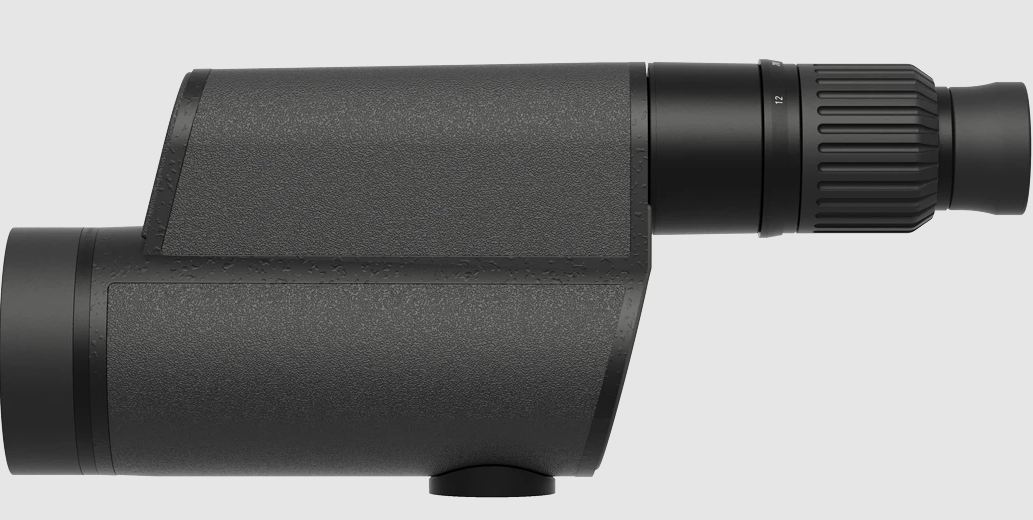
The Mark 4 scope is the best for spotting in different weather conditions for three reasons: fog-proof construction, low-glare lens, and excellent thermal sensitivity.
Together, these help you view objects when vision is restricted.
Pros
- Easy-to-use tactical frame
- 100% fog and waterproof
- Clear images due to glare reduction
- Multi-coated lens system resists damage
- Eye relief prevents fatigue
Our Review
Mark 4 is a remarkable hunting and spotting scope for poor lighting and high-glare conditions like hunting in fog under a full moon.
It has a multi-coated lens system, which improves the quality of viewing. The protective coats make sure the lenses do not scratch easily.
What we like the most about the Mark 4 is its glare reduction. Even if you use this scope in bright light, there’s no glare on the display.
The Mark 4 has a built-in ¼-20 tripod adapter that helps you set it on a tripod without having to get a separate tripod adapter.
Limitations
With super-sharp images, high resolution, premium price, and advanced feature set, the Mark 4 is really just suitable for professional or very experienced night hunters. People new to hunting or spotting should probably look for something else.
Bottom Line
The Mark 4 is a great scope for spotting in difficult conditions due to its multi-coated lens system and fog-proof construction.
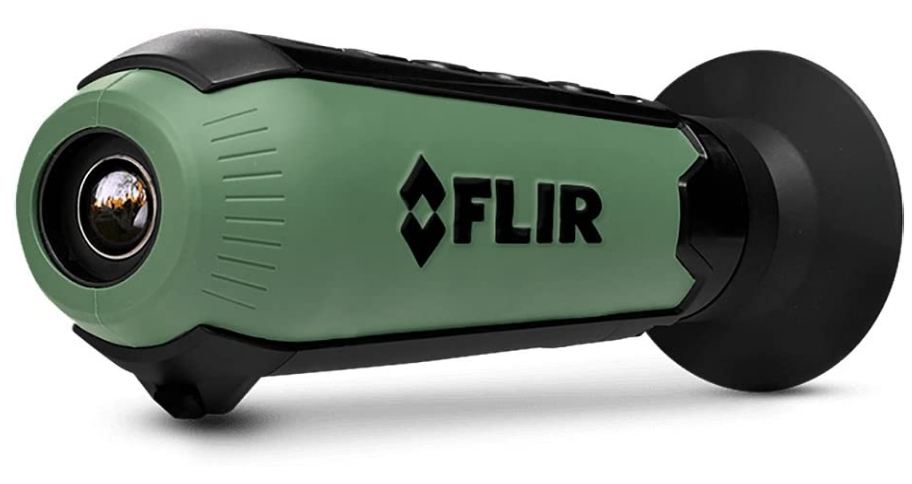
A small yet functional spotting monocular like the FLIR Scout TK makes finding and hunting animals easier in low light conditions. This is a compact monocular with some highly sought-after features.
Pros
- Light, pocket-sized monocular
- 4-button controls can be operated by one hand
- Senses heat signatures in complete darkness
- Rechargeable batteries last 5 hours
Cons
- The rechargeable battery is not user-serviceable
Our Review
The FLIR Scout TK measures just 6.7 x 2.3 x 2.4 inches, small enough to fit in your jacket pocket.
The simple 4-button design has all the controls placed together in a line, so you can operate them all in one hand. Very helpful when hunting, to say the least.
I wish more manufacturers would use this kind of common sense when designing manual controls…
Another good feature of the FLIR Scout TK is its 5-hour battery life. The rechargeable batteries can last a hunting spell, so you won’t have to carry extra batteries on your trip.
Also, this FLIR monocular comes with many useful accessories like a lens cap and a USB cable.
Limitations
The only problem with the FLIR Scout TK thermal monocular is that its batteries are not user-serviceable.
You will have to send the scope back to the manufacturer when the batteries have lived all of their charge lifecycles.
Bottom Line
The FLIR Scout TK is an equally good hand spotter for novice and expert hunters.
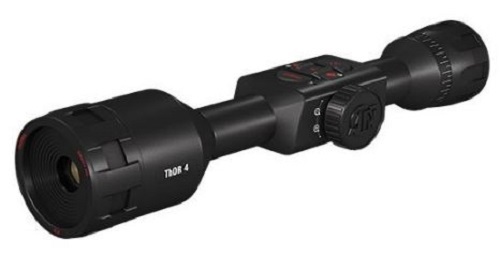
The ATN ThOR 4 is very similar to the ATN BINOX 4T binoculars in terms of optical performance and features.
The main difference is that ATN ThOR 4 is a monocular scope you can mount on a rifle.
ATN ThOR 4 is designed specifically for taking long-range shots. The integrated reticle and ballistics calculator increase your chances.
Pros
- Excellent optics.
- Comes with a quick detach mount.
- Built-in ballistic calculator.
- HD video recording and streaming.
- Extra-long battery life.
Cons
- Pricey.
- Takes experience and learning to make use of all the features.
Our Review
The ATN ThOR 4 is a feature-heavy thermal scope that’s designed to provide better spotting and targeting. It comes with a high-resolution 384x288 sensor that can detect animals up to 1,000 yards out.
The 2x-8x magnification gives you a close-up view, though you have to be careful not to zoom in too much to the point that it turns fuzzy.
For shot accuracy, the ATN ThOR 4 scope has a built-in stadiametric rangefinder that helps adjust the reticle to the right spot.
Most thermal scopes are great for tracking nearby targets. But most struggle mightily to keep an eye on animals beyond a couple of hundred yards.
The Pulsar Axion’s extra-long detection range of 1300 yards makes it especially suitable for big game and long-range spotting.
Pros
- High-precision, smooth digital zoom
- Detection range of 1300 yards
- Multiple color modes
- Lens cap
- Comfortable grip
Cons
- Slightly more expensive than comparable products
Our Review
The Pulsar Axion includes a 4x high-precision digital zoom that helps you get a better view of distant objects.
It also offers a diverse color palette, which helps you adapt your imaging to different lighting conditions.
The 16 GB internal memory will record your observations for later use.
The Pulsar Axion has an IPX7 rating, which means you can use it in heavy rain and even drop it in a creek (temporarily).
Limitations
The Pulsar Axion is a bit more expensive than similar scopes with similar features.
Bottom Line
The Pulsar Axion is great for hunters as it helps view landscapes in a diverse range of light conditions. Its detection range of 1300 yards makes it suitable for long-range hunting. Plus, it is IPX7 waterproof-rated.
If you are looking for a thermal scope that delivers clear and sharp images, we recommend the ATN Thor 4 640x480 thermal scope.
The ATN Thor 4 has the highest resolution sensor among our picks.
Pros
- High-resolution sensor.
- Long detection range.
- Long battery life.
- Video recording and streaming.
- One-shot zero calibration.
Cons
- Expensive.
- A bit of a learning curve.
Our Review
The ATN Thor 4 640 x 480 scope delivers the best image quality of any thermal scope or monocular in this buying guide.
The primary practical advantage of the high-resolution sensor in this series is you can see long distances while maintaining a high quality, sharp image. The ATN Thor 4 has a detection range of up to 830 yards, though the recognition range is closer.
The 1x-10x magnification provided in the base unit provides easy zooming with minimal loss in image sharpness - up to a point. Beyond 6x, you’ll get some fuzziness, and it’ll be harder to identify targets.
The ATN Thor 4 comes with many features designed to make hunting easier and to improve shot accuracy. These include One-Shot Zero reticle calibration, a built-in ballistic calculator, and an integrated smart rangefinder.
You can stream HD video via WiFi to an external device such as a smartphone or tablet. You can also record HD video onto an SD card.
The included Recoil Activated Video (RAV) feature ensures you don’t forget to capture the most crucial moments when firing fast.
As for battery life, the lithium-ion battery delivers an impressive 16 hours of continuous use.
Limitations
High-quality optics don’t come cheap. The high-resolution ATN Thor 4 is one of the more expensive thermal scopes in the market.
Something else to note is that the ATN Thor 4 has a bit of a learning curve. Because it has so many features, it’ll take some time to get the hang of everything.
Bottom Line
Though pricey, the
ATN Thor 4’s high-quality optics makes it a great buy for any serious hunters and outdoor enthusiast. It is also a great choice for hunters that want to record or stream HD video.
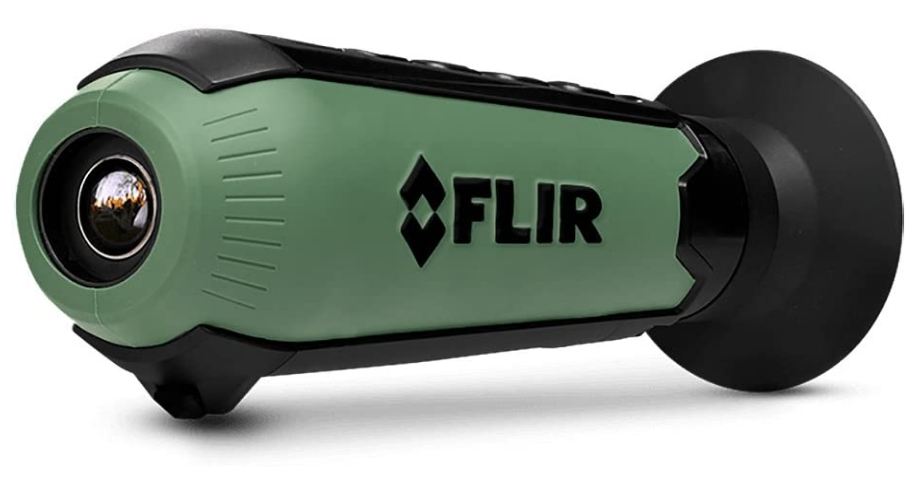
The FLIR Ocean Scout TK is one of the most cost-effective thermal monoculars on the market. It has a simple design, making it easy to use.
Pros
- Simple grab-and-go design
- Can see objects in water (some conditions)
- Very lightweight and compact
- Multiple color palettes for viewing and recording
Cons
- Battery life of 2 hours
- Slow refresh rate
Our Review
The FLIR Ocean Scout TK is amazingly lightweight at only 170 grams, making it easy and comfortable to carry.
This monocular helps you look at vessels and objects in the water. You can track marine animals up to a distance of 100 yards, so it is great for fishing trips too.
The Ocean Scout TK takes crisp images, and you can record up to 1000 thermal snapshots in it. This memory is more than enough for a couple of sighting adventures.
Since the Ocean Scout TK has multiple color palettes, you can choose a color mode that best suits your preferences.
It also helps you set different colors for heat emissions from objects, so you can track your target more easily.
Limitations
The Ocean Scout TK by FLIR works great, but it has a battery life of only 2 hours.
So you’ll probably want to bring a power pack or carry extra batteries. The refresh rate is also slow, so don’t expect the best images when things are moving fast.
Bottom Line
Considering the price, the Ocean Scout TK is an exceptional thermal monocular. It records observations, too, so you can check them once you get back from your expedition.
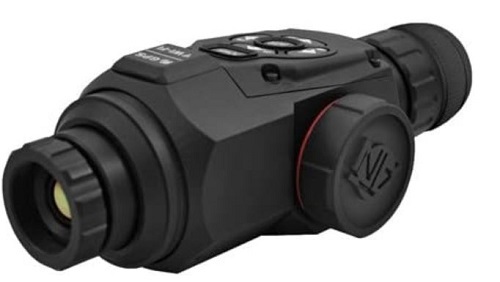
The ATN OTS-HD monocular delivers a clear and sharp image at a relatively affordable price tag.
It’s a great choice for hunters who want a better view of their target, both nearby and faraway.
Pros
- High image quality.
- Long detection range.
- HD video recording and streaming.
- Built-in rangefinder, compass, and gyroscope.
Our Review
A 384 x 288 sensor delivers a clear and sharp image up to a range of 625 yards. A built-in 3D gyroscope keeps the image steady and reduces shakiness, especially when you are moving.
The ATN OTS-HD also comes with an integrated compass and rangefinder.
You can record HD video on the ATN OTS-HD. You can also stream live video on a smartphone or tablet to let others share the fun.
The ATN OTS-HD runs on 4 AA batteries that will give you about 8 hours of continuous use.
Limitations
Compared to other monoculars, the ATN OTS-HD is heavy. It can get tiring to hold it up for long periods.
Bottom Line
The
ATN OTS-HD is a mid-range monocular that’s great for hunters looking for high-quality optics at an affordable price.
Hunting Monocular and Scope: Buying Guide
Buying the right hunting monocular or scope can really improve your hunting experience. So, you need to look for the right features in a monocular or scope before buying it. These include:
Screen Resolution
Screen or display resolution is the number of pixels in the viewing screen of a monocular or scope. It is usually higher than the thermal resolution value.
A screen resolution of 480 × 640 pixels is just fine for most thermal imaging scopes.
Higher values like 1280 x 720 pixels are exceptional, but scopes and monoculars that can truly take advantage of that resolution are expensive.
Refresh Rate
Refresh rate refers to the rate of refreshing images in a thermal vision device, measured in Hertz (Hz). The slower the refresh rate, the harder it is to see objects in motion.
A refresh rate above 30 Hz is considered acceptable for thermal scopes and hunting monoculars. Anything above 60Hz is as fast as your laptop’s screen.
Operating Temperature
Most people use their thermal scope in tough outdoor conditions.
Your scope or hunting monocular should be able to withstand extremely hot and extremely cold conditions. In general, look for a scope with an operating temperature of at least -20℃ to 50℃.
Durability
Rough landscapes mean more wear and tear to deal with. So, you should choose a durable thermal scope that can withstand minor drops and shocks.
Look for aluminum housings with double gasket seals for batteries and optics.
Color Modes
Color modes are another differentiating option for thermal vision devices. A range of color modes helps you adjust the visibility of the display to match your ambient light conditions.
Each person’s choice of color is somewhat unique, so having a wider range is generally a good thing.
Some people prefer darker shades as they emit less light, while others prefer lighter shades. Some people have difficulty seeing certain colors.
Wi-Fi/Bluetooth Connectivity
The ability to connect your scope or monocular with your smartphone helps you transfer data more easily.
This is why you might prefer a thermal scope with Bluetooth or Wi-Fi connectivity.
Day/Night Modes
Most thermal monoculars and scopes come with day and night modes. This helps you view your target easily despite the light conditions.
Ease of Use
The scope should be compact and lightweight so that it is easy to carry and use. The controls for magnification and other settings should also be simple and easy to access.
How to Choose a Thermal Imaging Solution
Whether you are buying a thermal monocular, scope, or binoculars, here’s what to consider when choosing the right one for your hunting needs.
For serious hunters, your best options range between $1,000 and $5,000 depending on the optics. Higher resolution, long detection range, and extra features like video streaming will add to the price tag.
Type of Thermal Imager
Monoculars: Monoculars have one objective lens and one eyepiece. A monocular is great if you want something lightweight and easy to use with one hand.
Binoculars: If you find it disorienting to use one eye for animal spotting, get thermal binoculars. Binoculars are more comfortable to use. On the downside, they are heavier and more expensive than monoculars.
Bi-oculars: Thermal bi-oculars are not very common and are expensive. A bi-ocular has one objective lens but two eyepieces. They are more comfortable to use compared to monoculars.
Scopes: Scopes are essentially monoculars that you can mount on a rifle. Riflescopes typically come with extra features such as rangefinder, adjustable reticles, and recoil activated video, among others. Some scopes can serve three duties - as a spotter, remote viewer, or mounted riflescope.
Thermal Resolution
The higher the thermal resolution, the better the image quality.
Entry-level thermal imagers typically have a resolution of about 160 x 120, while midrange imagers spot a 384 x 288 thermal sensor. Higher-end scopes and monoculars typically have a resolution of 640 x 480.
A mid-range resolution thermal imager is good enough for most hunters. It provides a clear image, even when zooming.
Detection Range
Detection range tells you how far you can spot an animal using the thermal imager. This typically ranges from 100 yards for low-end imagers to over 1,000 yards for high-end models.
Note that the given detection range is typically for large animals like deer and boars. Detection range may also vary from the recognition and identification range, which is the distance at which you can identify the type of animal.
With most thermal imaging devices at 1,000 yards you may be able to spot something warmer than the background. But to tell whether it’s a deer, a human, or a motorcycle, you’ll need to be closer.
Magnification
Most thermal imagers offer digital zoom, letting you get a close-up view of your target.
Obviously, higher magnification means more zoom. But high zoom can significantly distort image quality.
With most thermal scopes, monoculars, and binoculars, 4x-6x zoom is the maximum useful magnification.
Some more expensive thermal scopes offer higher optical zoom. This magnifies the image without losing sharpness.
Built-in Rangefinder
Many scopes and monoculars today have a built-in stadiametric rangefinder that calculates the distance to a target.
A rangefinder can greatly improve shot accuracy and help you estimate the walk time to get closer.
Color Palettes
Multiple color palettes are a must-have in any thermal imager, even a cheap one. Being able to cycle through different colors lets you choose the best palette for a particular situation.
Video/Image Recording
If you’d like to store and share recordings of what you see through your scope, look for one that offers video and/or image recording.
Video Streaming
Some thermal imagers have wireless connectivity, either WiFi or Bluetooth, that lets you stream a live image of what you see on a smartphone or tablet.
Video streaming is handy if you are hunting with friends or family. They can all share in the fun.
Battery
Check the battery life of the scope or monocular. You should get at least 4-6 hours of continuous use before needing to recharge or replace the batteries.
High-end thermal imagers come with high-capacity batteries that can provide well over 10 hours of use.
Price
The best price comes down to what kind of optics you want and how much you are willing to pay.
If you are a beginner and don’t need extra-high resolution or long detection range, you can easily find a good imager for under $1,000.
Binoculars and Scopes For Hunting: Frequently Asked Questions
What is the Most Powerful Monocular?
A monocular with a high magnification power of 10x to 12x is considered the most powerful.
For Hunting, What are the Differences between Binoculars and Monoculars?
Binoculars and monoculars both have their own advantages when it comes to hunting.
Usually, binoculars have a wide angle of view, while monoculars offer a true field of view.
This makes the latter better for spot targeting and the former for landscape sweeping.
Monoculars are lightweight and compact, so most hunters prefer using them.
Is it Possible to Take Photographs with a Monocular?
Yes, it is possible to take photographs with a monocular. But, you will have to use your smartphone with the monocular to capture shots.
Is it Possible to View the Moon with a Monocular?
Monoculars help you view the moon and stars more clearly, and you can even photograph them. And since monoculars are easy to carry, you can even use them for extended periods.
Is a 3-9x40 Scope Appropriate for Hunting?
A 3-9x40 scope is appropriate for hunting, especially for novice hunters.
It is easier to configure, even if you do not have much experience with scopes. However, experienced hunters prefer using more advanced scopes.
Conclusion
While thermal technology costs more than night vision, it’s allows you to do more at night.
For hunters, thermal imaging is the best technology for spotting and tracking animals in all kinds of environments, be it forests, grasslands or snow.
Our entry-level pick for short-range spotters is the FLIR Scout TK. If you need to really watch your budget, then get the Leupold LTO Quest.
Our mid-range pick for thermal spotting is the Pulsar Axion Key XM30. It’s perfect for hunters looking for a balance between affordability and optical performance.
Our high-end pick for serious hunters is the ATN ThOR 4 640 if you want a scope, or the ATN BINOX 4T 384 if you prefer binoculars.